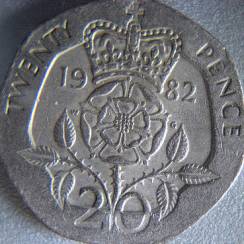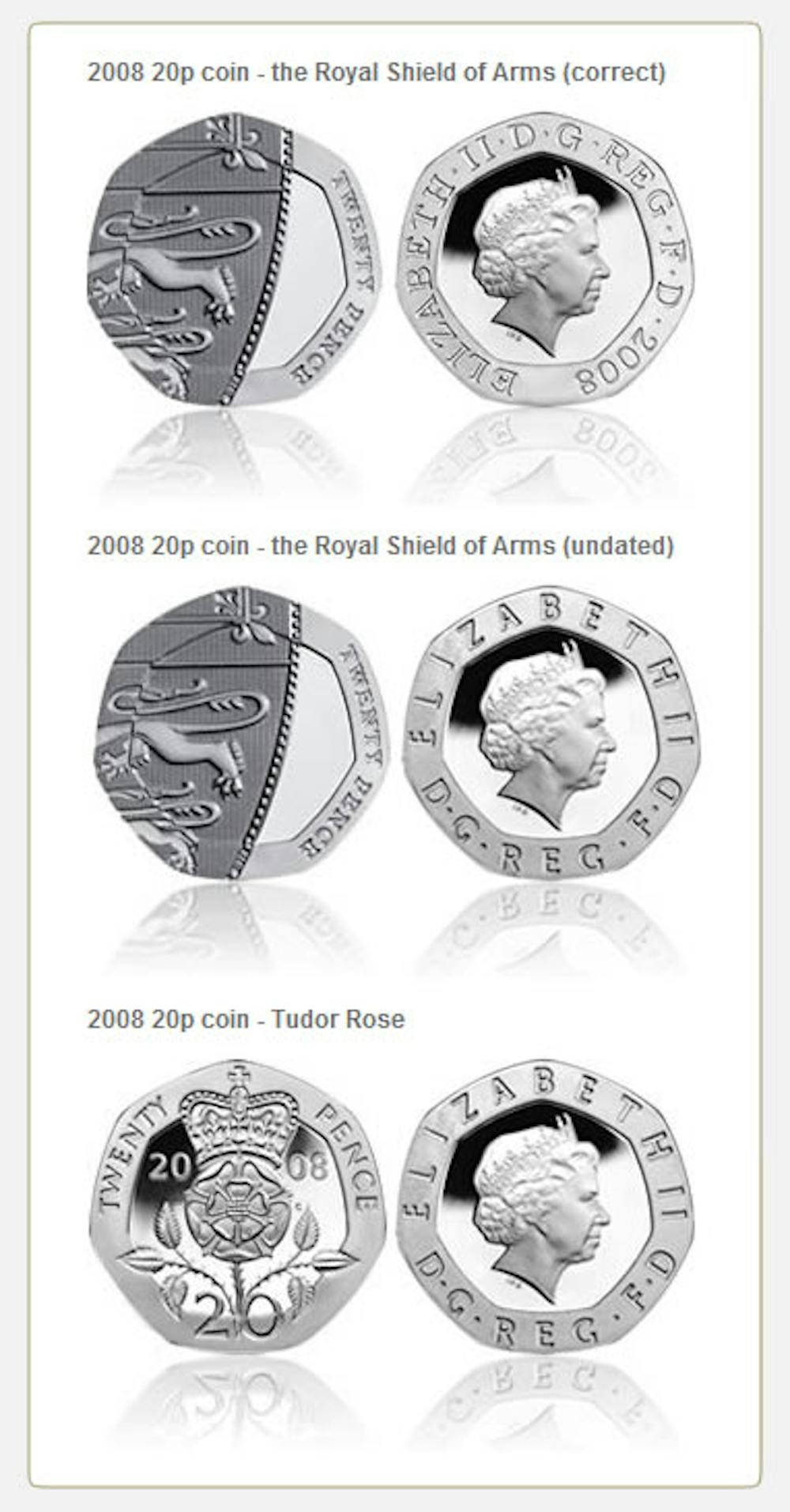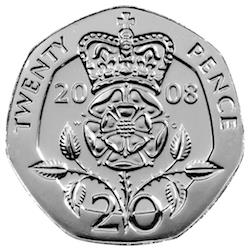<- Click Here to go back to the other Coins in Circulation page
The 20p was first issued in 1982 and has proved a popular denomination, being struck in large numbers ever since. Five different obverses and two reverses have been used to date. In 2008 an error (undated) coin known as a ‘mule’ was made using mis-matching obverse and reverse dies.
20p Twenty Pence UNDATED - Error Mule Coin - 2008 VERY RARE Twenty Pence. An auction house has received thousands of calls and emails from around the world as a result of plans to sell a rare 20p piece worth thousands of euro. We provide free challenge coin design, and free overnight shipping to ensure you get the best challenge coins your money can buy, as quickly as possible. Our team is standing by to help you create an amazing coin today, so please don’t hesitate to call us at 800-818-1105 or click to get a quote now!
Specifications are shown at the bottom of this page.
Obverse Type 1, used 1982 – 1984 (bust design by Arnold Machin):
Reverse Type 1, used 1982 – 2008 (design by William Gardner):
Edge: Plain.
The design:
Heraldic English rose, royally crowned. ‘TWENTY PENCE’ and the date on either side. ’20’ below the rose.
Dates:
1982, Mintage 740,815,000.
1983, Mintage 158,463,000.
1984, Mintage 63,350,965.

Collectability/Scarcity (all): 1 (for scale details see here)
Obverse Type 2, used 1985 – 1992 (bust design by Raphael Maklouf):
Obverse Type 2 (larger variant), used 1992 – 1997 (bust design by Raphael Maklouf):
Reverse Type 1, used 1982 – 2008 (design by William Gardner):
Edge: Plain.
Dates:
1985, Mintage 74,273,699.
1986, None made for circulation, 167,000 were made for sets.
1987, Mintage 137,450,000.
1988, Mintage 38,038,344.
1989, Mintage 132,013,890.
1990, Mintage 88,097,500.
1991, Mintage 35,901,250.
1992, Mintage 31,205,000 for both types, see below.
1993, Mintage 123,123,750.
1994, Mintage 67,131,250.
1995, Mintage 102,005,000.
1996, Mintage 83,163,750.
1997, Mintage 89,518,750.
Collectability/Scarcity: 1. Except 1986 and 1992 with large head: 3 (for scale details see here)
Notes for 1992: A slight enlargement was made to the Queen’s head during 1992 leading to two slightly different coins being made that year. The variety only exists for 1992. All of the 1993-1997 coins use the larger head and all of the 1985-1991 coins bear the smaller head.
The 1992 small head coin was thought to be scarcer than the large head, but new information would seem to imply that the large head coins were the coins that were circulated in large numbers, did not go into the year sets and are now hardest to find (especially in top condition as most have seen normal use). The easiest way to tell the difference is that the small head bust has a much sharper point where the neck ends at the bottom right. Both types are shown above.
Obverse Type 3, used 1998 – 2008 (bust design by Ian Rank-Broadley):
Reverse Type 1, used 1982 – 2008 (design by William Gardner):
Edge: Plain.
Dates:
1998, Mintage 76,965,000.
1999, Mintage 73,478,750.
2000, Mintage 136,428,750.
2001, Mintage 148,122,500.
2002, Mintage 93,360,000.
2003, Mintage 153,383,750.
2004, Mintage 120,212,500.
2005, Mintage 124,488,750.
2006, Mintage 114,800,000.
2007, Mintage 117,075,000.
2008, Mintage 11,900,000.
Collectability/Scarcity (all): 1 (for scale details see here)
Obverse Type 3, mismatched with Reverse Type 2
This is the famous ‘dateless’ error coin, which uses the wrong (older) obverse with the new reverse that was introduced in 2008. Technically it’s known as a mule when obverse and reverse dies get mixed up to create a coin that should not have been made (the last time this happened for a Royal Mint circulation coin was in 1983 on the 2p coin with NEW PENCE. It also happened in 1994 for the Bank of England £2 coin – where some gold proof versions of those were made with the incorrect obverse from the double sovereign).
The new Matthew Dent designed reverse doesn’t include a date, and this meant that the obverse was modified to show the date instead. Somehow someone failed to notice and loaded up the Royal Mint machine with the dies for Obverse Type 3 and a large number (probably about 100,000) were struck and released into circulation. Initially a few collectors noticed them and were puzzled. They started changing hands for about the same as they are currently. About six months after they were made, the media got hold of the story and all of a sudden everyone wanted one and people were genuinely paying far too much for them. There was a constant stream of them available online etc as people wanted to cash in and all of a sudden everyone was speculating. This attracted some very dubious characters and there were stories of meetings and attempted muggings and not to mention people that were clearly selling normal coins with stolen pictures or with cleverly worded descriptions so that the buyers actually received two coins (both normal ones) and not to mention the odd normal coin that had its date filed off! It was utter madness.
Beware of recent Chinese made forgeries of the dateless 20p. The fakes usually have a proof-like appearance and the Queen’s eye and hair detail looks wrong (among other minor differences).
Collectability/Scarcity: 5 (for scale details see here).
Obverse Type 4, used 2008 – 2015 (bust design by Ian Rank-Broadley):
Reverse Type 2, used 2008 – date (design by Matthew Dent):
Edge: Plain.
The design:
Lower right section of the Royal Coat of Arms of the United Kingdom.
Dates:
2008, Mintage 115,022,000*.
2009, Mintage 121,625,300.
2010, Mintage 112,875,500.
2011, Mintage 191,625,000.
2012, Mintage 69,650,030.
2013, Mintage 66,325,000.
2014, Mintage 173,775,000.
2015, Mintage 63,175,000.
*Note that for 2008, for 2009 and possibly 2010 a reverse die break seems to have occurred leading to some coin reverses appearing to have an upside down ‘1’ in the middle of the raised rim at the bottom of the reverse as shown below.
Irish Coins 20p


Obverse Type 5, used 2015 onwards (bust design by (Mr) Jody Clark):
Reverse Type 2, used 2008 – date (design by Matthew Dent):
20p Coin With Horse
Edge: Plain.
Dates:
2015, Mintage 131,250,000.
2016, Mintage 161,000,000.
2017, None made for circulation, they are only available from BU sets.
2018, None made for circulation, they are only available from BU sets.
2019, Mintage number not yet know.
Specifications for all 20p coins:
Size: 21.4mm
Width: 1.7mm
Metal Composition: Cupro-nickel (84% copper, 16% nickel)
Weight: 5.00 grammes
<- Click Here to go back to the other Coins in Circulation page

The twenty pence coin is a circulating denomination of the British (decimal) Pound Sterling. 20 pence equal one fifth of a pound.
In August 2005 the Royal Mint launched a competition to find new reverse designs for all circulating coins apart from the £2 coin. The winner, announced in April 2008, was Matthew Dent, whose designs were gradually introduced into the circulating British coinage from mid-2008. In a world-first concept, the designs for the 1p, 2p, 5p, 10p, 20p and 50p coins depict sections of the Royal Shield that form the whole shield when placed together. The shield in its entirety was featured on the £1 coin (now discontinued).
The new 20p coin design, which replaced the earlier 20p design by William Gardner, depicts the meeting point of the second and fourth quarter of the shield, showing the Lion Rampant of Scotland and the Lions Passants of England; the value and denomination, in words: TWENTY PENCE are around right. The date no longer appears on the reverse of the coin, and has instead been added to the obverse, where the lettering has been adjusted so as to fit the date in.
To help identification and avoid confusion with similar sized coins the 20p is seven sided and like the 50p is an equilateral curve heptagon. The shape, with its constant rolling diameter, means that it is readily acceptable in vending machines.
20p Coin Pictures
Twenty and fifty pence coins are legal tender only up to the sum of £10; this means that it is permissible to refuse payment of sums greater than this amount in 20p coins in order to settle a debt.
20p Coin With Horse
Coins issued in 2015 have now been circulating for six years.